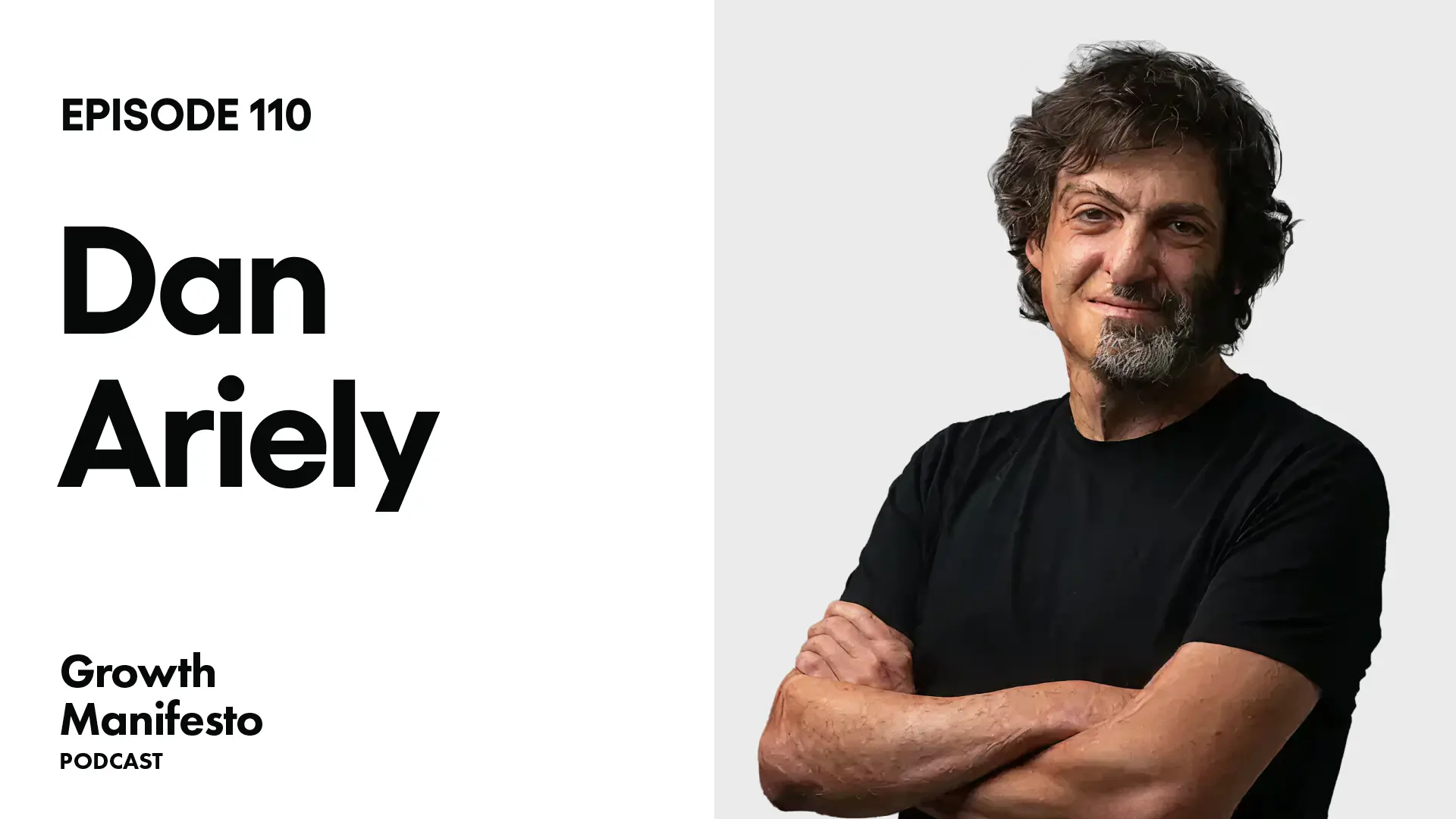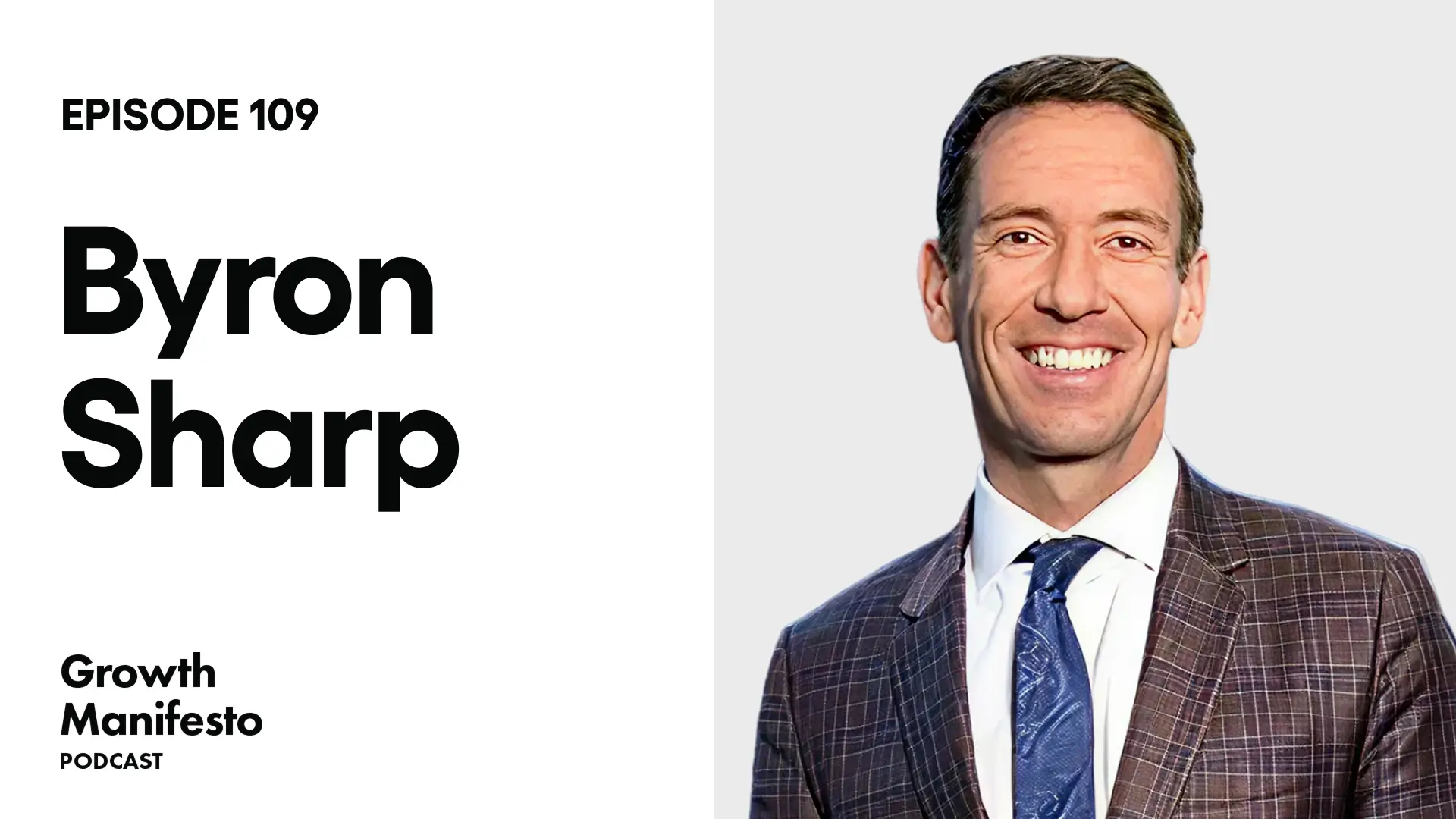How to use strategic marketing to become a market leader
This episode is with Jay Abraham – CEO and Founder of The Abraham Group. Jay is a marketing legend that has helped more than 10,000 clients in more than 1000 industries solve complex problems and drive significant growth through a different way of thinking. His clients include people like Tony Robbins and Daymond John, and companies like AT&T, Fedex, Microsoft, HBO, Being, Baskin Robbins, Shell, Merrill Lynch and IBM, and he’s helped generate more than $20B in sales over his career. In this episode we talk about how to become a market leader by thinking differently about marketing and business growth.
LINKS
- Jay Abraham’s Website
- Jay Abraham on Facebook
- Jay Abraham on Twitter
- Jay Abraham on Instagram
- Jay Abraham on LinkedIn
—
You’re listening to The Growth Manifesto Podcast, a Zoom video series brought to you by Webprofits – a digital growth consultancy that helps global and national businesses attract, acquire, and retain customers through digital marketing.
Hosted by Alex Cleanthous.
- YouTube: https://www.youtube.com/c/GrowthManifestoPodcast
- Instagram: https://www.instagram.com/webprofits/
- LinkedIn: https://www.linkedin.com/company/web-profits/
- Facebook: https://www.facebook.com/Webprofits/
- Twitter: https://twitter.com/webprofits
- Agency: https://www.webprofits.io
SHOW NOTES
- 00:02:18 Jay Abraham introduction to the Growth Manifesto Podcast
- 00:03:22 What is Business Marketing? Why do you think your thinking has helped companies?
- 00:04:57 Why is looking for solutions to business problems important?
- 00:07:15 What is Explosive growth?
- 00:11:25 What does it take for a company to become truly great?
- 00:14:45 How do you define strategy and how do you think about it?
- 00:16:03 What is the importance of strategy for growth?
- 00:18:11 Can you separate marketing from the business with strategy?
- 00:20:10 What is your advice to those companies that are fully established for a while but come to the point where they fall into flat growth? How can they recover?
- 00:23:30 How much should companies look at their competitions?
- 00:25:50 What do you think is the importance of a brand?
- 00:27:17 How do you stand out?
- 00:34:18 What is the difference between risk reversal and money-back guarantee?
- 00:36:19 What is upside leverage?
- 00:41:25 What is maximizing underperforming assets?
- 00:45:11 Is there a way where a company can start to create a list of their assets?
- 00:52:14 How can the audience reach you?
TRANSCRIPT
Jay Abraham:
It’s very probable, not even possible that the way you’re doing it, the market you’re targeting, the way you’re targeting them, the offers you’re making, the ways you’re monetizing it, the what you’re doing or not doing to extend or expand or perpetuate that monetization is a fraction of a fraction of what’s really possible. Most people are trained to default towards one source of revenue. They’re trained to accept results as given. A lot of people in business, they focus most of their time on bringing a buyer in, not on how to make the buyer more profitable or find a lot more residual value, ongoing profit from that relationship. Most people are trained in very traditional revenue-generating thinking. They don’t look at alternative ways to accomplish it. Most people don’t realize you can have multiple approaches going concurrently. Most people who get a lot of their business from things like word of mouth or referral don’t recognize it, they accept it as organic reactive, episodic, intermittent. They don’t realize they could have up to 125 different strategic, proactive systematic ways to get a lot more referrals. I mean, there’s just a lot of things out.
Alex Cleanthous:
Today, we’re talking with Jay Abraham, CEO and founder of the Abraham Group. He is a marketing legend that has helped more than 10,000 clients in more than 1000 industries solve complex problems and drive significant growth through a different way of thinking. His clients include people like Tony Robbins and Daymond John, companies like AT&T and FedEx, a HBO, a Baskin-Robbins, Shell, the list goes on. And he’s helped to generate over $20 billion in sales across his career. He’s helped more companies, businesses and entrepreneurs than anyone else in the world. I first actually heard about Jay in the late ’90s. I was in my early 20s and his thinking literally changed how I approach everything I do in business. So I’m really excited about this one. Today, we’ll be talking about how to become a market leader by thinking a bit differently about how you approach the marketing side of things and the business side of things. And just quickly before we get started, make sure to go ahead and hit that subscribe button so you get the latest episode as soon as they’re released. Let’s get into it. Welcome Jay.
Jay Abraham:
Alex, thank you for inviting me. I look forward to the conversation.
Alex Cleanthous:
Well, let’s get straight into it. How do you think about business and marketing? And why do you think that your thinking has helped so many companies over the decades because it’s helped a lot?
Jay Abraham:
Yeah. The answer is probably grounded in what I’m the strongest at. I’ve had the unexpected good fortune of being involved in over a 1000 industries worldwide, not businesses. And it’s given me an enormously broad, deep, and uniquely expansive understanding of all that’s possible, all that’s possible in business strategy, business models, marketing, advertising, value creation, strategic alliances, a lot of things that most people who spend a life in one or two industries wouldn’t fathom. And I’ve gotten to try out an enormous amount of hypotheses and beliefs into the real market. And I’ve had to do it through translation on worldwide sort of forums. And it’s given me an understanding of things that transcend the way most people think about it. I’ve got a much more expansive sense of what you can do, how you can do it, where you can do it, why you can do it, what all is possible. And most people don’t have the empirical experience to understand and appreciate more possibilities.
Alex Cleanthous:
So one of the things that you talk about is to look for solutions to business problems, but within other like industries. So why is that so important?
Jay Abraham:
Well, it’s important for a number of reasons. First of all, if you study breakthroughs throughout history, the majority of them did not come from inside the industry, they came from outside, people would look at something and realize they could translate or apply it to a totally different application. Easy examples, fibre optics redefine telecommunication, but it wasn’t created in telecommunication. It came from aerospace and somebody borrowed it and adapted and adopted it. Federal Express created a whole industry by borrowing from the United States the hub-and-spoke check clearing process that the Federal Reserve bank, our banking system used to make sure people didn’t bounce checks. Rogaine came from pimple medicine. Viagra came from art medicine. Ballpoint pen, I don’t have my pen, I’ve lost my pen temporarily, ballpoint pen or roll-on deodorant was borrowed from each other. So that’s the first distinction.
The second is the concept of best practices is frankly and actually flawed because usually, you’re learning the best practices from a vertical industry. And by and large, they’re going to be incremental, they’re going to be incremental. They’re not going to be explosive practices. They’re things that everyone else is doing a little bit better, worse best practices. They’re not the best breakthrough practices, they’re not the highest, best, safest, fastest, most profitable, efficient, effective, they’re just the best practices that an industry has discovered.
When I got started, I realized, excuse me, I’m on airport and right on the runway and a lot of planes take off, I learned that there’s a lot of higher, better, faster, safer, more powerful, profitable, productive ways to do things that other industries do commonplace, but people in a different industry are never even exposed to. So it sort of there’s the basis for it.
Alex Cleanthous:
And so you talked about explosive growth and you often talk about the fact that companies are successfully stuck with above market performance, but the order of magnitude, like significantly higher profits is frequently possible. So what do you mean by that?
Jay Abraham:
Well, I mean, it’s exactly that. If you are making money and you are making more money than most of the other companies, people, professionals you’re competing against, you’re happy camper, but it’s very probable not even possible that the way you’re doing it, the market you’re targeting, the way you’re targeting them, the offers you’re making, the ways you’re monetizing it, the what you’re doing or not doing to extend or expand or perpetuate that monetization is a fraction of a fraction of what’s really possible from the time the opportunity, market access, advertising, interaction.
And when you realize how many better ways you can do it, it’s very possible to make ads produce. I mean, there’s plenty of research. I have lots of case studies. You can make an ad double, redouble, redouble it’s either quantitative or qualitative or both quantitative and qualitative result. Meaning you can get an ad to do up to 21 times more yield, more results, more response, more numbers if you know how to do headlines, risk reversal, positioning changes, credibility, value creation, proof elements, bonuses, you can convert more people when you get a prospect, you can get people to buy more at the point of sale, you can get them to buy longer, you can get them to buy things from you even if you don’t have more than one product to sell by making partnerships, you can penetrate lots different markets, you can not just go to media or not just knock cold on doors.
You can find all kinds of companies, influencers, media, organisations, associations that have access to the same market and partner with them. You can take methodology that you have perfected that you only use in one market or in one application and licence partner, profit share, saving, share with us. I can go on and on and on, but those are a few.
Alex Cleanthous:
Yeah. And so what do you think, I guess, is the reason that quite a lot of companies aren’t thinking like this, or they don’t even consider this? Is it because they’re stuck in their vertical and they’re having a look at their competition and they’re going for incremental improvement?
Jay Abraham:
Mostly and most people are trained to default towards one source of revenue, they’re trained to accept results as given. A lot of people in business, they focus most of their time on bringing a buyer in, not on how to make the buyer more profitable or find a lot more residual value, ongoing profit from that relationship. Most people are trained in very traditional revenue-generating thinking. They don’t look at alternative ways to accomplish it. Most people don’t realize you can have multiple approaches going concurrently. Most people who get a lot of their business from things like word of mouth or referral don’t recognize it, they accept it as organic, reactive, episodic, intermittent. They don’t realize they could have up to 125 different strategic, proactive, systematic ways to get a lot more referrals. I mean, just a lot of things out.
Alex Cleanthous:
And so what do you, like, are there a few things or what does it take for a company to become truly great, like the FedExes of the world? So what does that take for a company?
Jay Abraham:
It takes a lot and it takes a little. You have to understand what I call the strategy preeminent, which is to establish your product company, people in the eyes of the target audience is the only viable solution, the most trusted advisor for life, the only source they could possibly go to or choose. In order to deliver on that, you have to be willing to give them advice that is different and more relevant, you have to be able to understand and express and articulate and verbalize what they really want more of, less of, the reason why they’re trying to really get what it is you offer, your product or service does for them in a better, clear, more powerful way that resonates other than other people. You have to see yourself as somebody who has a moral responsibility and obligation and the privilege to try to help everyone in the market that you can serve better than your competitors, not because you want to be the most successful, but you want to be the most impactful and create the most value for your audience market.
You have to look at your role in the market on many dimensions. I think, I tell people, you have to see the relationship you have with the buyer and have them be seen as a client, not a customer. And the reason why, I think in Australia, they do more of that actually. But if you look at the definition of a customer, it’s somebody who buys a commodity or service. If I call you a customer, I’m saying, “Hey, Alex, I’m no better than a generic commodity or a service.” If you look at somebody who is a client, the definition of that is somebody who’s under the care, the protection, the wellbeing of another.
If you’re going to be preeminent, you have three categories of clients you have to serve. The first and the primary one are certainly the ones who pay you. The other two are the people you pay, your employees, your team members, your colleagues, and your advisors. You have to be committed to grow and develop them and their success. You want everyone to be collaborative. You don’t want to just squeeze everything you can out of people. You want to grow and develop everything you can within them. So their value, their contribution, their passion, their collaboration is off the charts. So those are a few things.
Alex Cleanthous:
And there’s quite a lot there, it is also simple in the fact that you want to be the company that provides the most value and solves the biggest problems. And that thinks a bit looks differently to the rest and so that you stand out and so that you are seen as the obvious choice, is that right? Like, is that a good way of summarising it?
Jay Abraham:
It’s the obvious choice, the only choice, permanent choice, even if you only sell something one time that they can always turn to, they can always refer to, they can always trust.
Alex Cleanthous:
So you talk a lot about strategy and strategy is one of those esoteric words sometimes where there’s no real definition, but there’s a 100 definitions and there’s lots of different ways of thinking about it. How do you think about strategy? How do you define strategy first and then actually, how do you think about it?
Jay Abraham:
Well, to me, strategy is the overall big, long term game plan you’re playing and everything you do tactically are activities, efforts, anything that is designed to advance and enhance the long term game. It’s not, it’s how you think about your role in the life of the market that you’re serving and what you’re trying to accomplish, it has to do with how you’re seen as far as your marketing positioning, has to see what your business model is. It has everything. And then everything else you do is designed to feed to that. Most people, their strategy is that they’re being tactical. They just do things intermittently, they don’t have everything integrated together, the left and the right, a person in the business doesn’t correlate. There’s no congruence. People are playing a short game instead of a long game. They do things for the moment, they run ads if more just transactionally, but strategy is the long term game that you’re playing and everything you do needs to be based on that.
Alex Cleanthous:
And so how important is it for growth just to have a solid, strong strategy?
Jay Abraham:
Well, I would say it’s all important. I mean, in the world today where you’ve got enormous quantities of generic competitors and then you have enormous alternative ways to get the same result that your category of business offers, you have to be able to play a longer game. You got to know, what am I going to do? I mean, there’s five facets that I think, and I see if I can remember, I haven’t used this for a long time, of business wealth. One is having certainty, you’re going to have current income.
The other is having certainty, you’ve got a constant flow of future income. The other is finding opportunistic windfall income. And the other is the finding a lot of fulfilment, psychic, emotional income that you and your whole team gets out of being on a mission and a crusade in behalf of the market you’re serving and the value you’re creating for them or the protection you’re establishing, or the enrichment or the entertainment, whatever your product, service does. And the last is the asset value you’re building. And if you’re not playing that whole integrative game and playing it relative to your competition, playing it well above the madding crowd, there’s no way you’ll win. And today, if you don’t have a fabulous and a sustainable and defendable and preemptive, preeminent strategy, the odds of staying vibrant, viable, successful and profitable is very low.
Alex Cleanthous:
I mean, I’m loving your answers by the way, they’re very complex answers, but they’re very simple as well, but I know for the listeners, there’s a lot. So I think if someone is listening, they should probably hit their rewind button a couple times and hear some of your answers again, because you cover so many things in a very short sentence structure. So it’s really, really impressive. But let me ask a question, right?
Jay Abraham:
Sure.
Alex Cleanthous:
Can you separate the marketing from the business within the strategy?
Jay Abraham:
I think marketing is an extension of your strategy. And if you don’t market, your business will not grow, you grow or die. You’re either a multiplier or diminisher of everything you do. Your place in the marketplace, your innovation, your contribution, your value creation, your benefits to the market. But I think no, it’s all integrated. The big problem with most people is they operate silo-like and modular-like and there’s no integration, there’s no sophistication and thought, it’s pretty basic, let’s see how.
And they also, I would say, there’s a concept, there’s two concepts, there’s a 2D thinker and there’s a 3D thinker in business. And Alex, a 2D thinker is somebody who looks at the business in terms of revenue minus expense equals profit. And it’s very static and it’s very transactional. A 3D thinker looks at one more dimension, residual yield. They don’t look at, okay, I’m going to run $100,000 of ads, I’m going to get $400,000 of sales. So now I’ve got, if it’s an annualized, I got a $4 million business theoretical. And after expenses, I make 200 grand. The 3D thinker says, I am investing in assets, buyers who will pay a residual return on investment over and over again if I strategically know how to mine, manage, monetize and perpetuate the relationship. It’s a whole different way of thinking.
Alex Cleanthous:
So if a company that’s being established now for a while, they’ve hit their growth goals for a decade, and now they’ve hit a point of they’ve come to a point where things have started to become flat from the growth perspective, what would you advise them to look at to really change the trajectory of their growth again?
Jay Abraham:
Well, I mean, for first of all, are you driving it by one revenue approach? If the answer is yes, how much experimentation have you done to make that more powerful? How many more approaches could you add? We try to get most of our clients to have nine different sources of generating revenue from their market, penetrating all kinds of different aspects.
We use a military concept called force multiplier effect, which is going at it from many different avenues at the same time. I would say, how many different product, service offerings do you have? I’d say, what else do you know about the buyer that you could be offering other related products? I’d ask, what do they buy before, during, after, instead of what they buy from you? I’d ask, who else has a trusted relationship with them that you could basically partner with and could take your product, service to their market and reciprocally, you could take their product or service to your market? I would ask, do you get any of your business from referrals or word of mouth? If so, do you have even one formalized, systematized referral generating strategy in place? If not, we know 125 of them. I go on and on, but those are a few.
And I’d also say, what are you doing on R&D, research and development? Are you researching your competition? What do you know about their strengths or weaknesses? I would say, what do you do to try to develop as far as new products or new sources of products? What do you know about your buyer that you’re not doing? What are you researching and developing and trying in terms of marketing, messaging and the vehicles? And then you’ve got three ways to grow a business.
I said, you increase the number of buyers, you increase the size of the transaction and thus the profit per transaction, you increase the frequency or the utility, meaning how many more ways you can make ethical profit off of that buyer. Then you’ve got three advanced ways, Alex, you can penetrate a new market or niche every year, you can introduce a new product or service every year, and that new product or service gives you enormous advantage. You can use a modest one to start a relationship and make it easier than maybe what your main product or service sells for, get a lot more people to start that you can then move to larger buyers. You can take new products or services and add it to the normal product to double or redouble the profit per sale. You can get an advance, an expensive product and use it to extend the profitability, the lifetime value. You can get certain products that you give back to unsold prospects or inactive buyers and remonetize them. There’s a tonne of things you can do that nobody thinks about.
Alex Cleanthous:
And there’s a massive list for people that are stuck, you should transcribe it or just actually help with the transcript and actually just document that because there’s a lot of ideas that obviously you should get all the Jay stuff because it’s amazing. There’s a couple of things that you mentioned, the first is competition. How much should companies look at their competition in general?
Jay Abraham:
If you don’t know who you are competing against and you don’t know how they are competing and you don’t know why people are buying from them rather than you and you don’t know where they are competing and you don’t know why they are doing what they’re doing and you don’t know how well they are doing, how can you imagine you’re going to outperform them? I mean, most people operate in a vacuum. We almost laugh, although, a fine line of gossamer-thin between pathos and humour, sometimes we just cry. Any new client I make answer a 200 question assessment. Most of them can’t answer it all, but there’s a huge portion of competitive knowledge, what do you know about your competitor? Where do they market? What’s their positioning, higher, lower? How do they do it? Why do people buy from them instead of you? Why do they buy from you instead of them? Where are they strong at, marketing, product, support, positioning, brand? And why? And most people just go, “I don’t know.”
Alex Cleanthous:
Yeah. Okay. And so you want to be across it and you want a systemized way to stay across it. Is that right?
Jay Abraham:
It’s more than right. It’s vital. It’s mission critical if you want to be more than mediocre.
Alex Cleanthous:
So you’re looking at the competition from one side to understand them, but on the other side, you don’t want to do the best practices and to do what everybody else is doing. So to your earlier point, you want to be looking across industries and how other companies are approaching certain problems.
Jay Abraham:
That’s where advantage comes from. And I mean, in all of business, you want advantage, ethical advantage, but you want total advantage. You want to know how to be more relevant, you want to be more irresistible and unbeatable in what you say, you want to be able to reach them from access vehicles nobody else does. So you have advanced access. You want to be able to make your product have more perception of value and deliver it, whatever that perception is. You don’t want to be mediocre or generic. I mean, all these things, they’re not just mandatory, they are necessities if you want to be more than an average business in a very competitive world.
Alex Cleanthous:
What do you think about the importance of a brand in terms of a company’s success and growth? And how does that fit into some of the marketing tactics like special offers and risk reversals and all that compared to the brand?
Jay Abraham:
I think everybody associates with different categories, but different representative positions, they relate with people that have the highest technology, people that have the coolest looking, people that have the more status, people that have the greater value, pricing, people that have a certain category of people that tend to be their audience, people that have greater service support. And I think you have to figure out what it is that you can offer your market that you and your company can deliver in a way that the competition doesn’t? Because if all you do is offer everything that everyone else does the same way, then you have no advantage. If you’re offering that which no one offers in ways nobody offers, you have a tremendous Advantage.
Alex Cleanthous:
And so a lot’s changed in the last 20, 30 years in terms of the competition, the accessibility to the market through the internet and so on. And so like in that space, how do you really stand out? Like, is it to really understand the customer to run the qualitative surveys?
Jay Abraham:
The better you are, Alex, the more you understand the mind of your market and you can put into words what they feel that they want more of, less of, and why and how, and they see that you really get them and you understand them at a deeper level. That’s one thing. Second is the more you give them reasons why that makes sense of why they should deal with you, why you are a better choice, why you are doing more, caring more, protecting more, contributing more, the more that you make the proposition harder to say no to, the more that you have peer confirmation, the more you have influencers who endorse you. And legitimately all those things make a big difference.
Alex Cleanthous:
So before, you spoke about the strategy of preeminence is to be seen basically as the only choice, is that done through content, through creating content that answers questions?
Jay Abraham:
It’s holistic, Alex. It starts with a belief system that you’re going to basically be, you’re going to provide them and whatever the niche that you’re focused on or the approach or the positioning with you’re going to be the greatest possible choice because, and you can answer the because, and it is integrative. It’s not just trying to append a one trick pony tactic to get advantage. It’s having congruence and authenticity, like I am set up to be frankly very elevated in the entrepreneurial niche.
People come to me and they expect me to know more than other people, they expect me to be able to assess better, they expect me to give them better strategy, marketing, advertising, they expect me to be something of a masterful thinking partner and being able to identify issues they’re not even aware of that are going to be implications or opportunities. They’re expecting me to care more about them than about myself and give them advice they can trust. They’re expecting me to protect their downside and not let them make wild dangerous overly expensive commitments that might go bad. They’re expecting me to help them think at a deeper level than they do themselves. And I have to live up to that expectation because that’s the brand perception that I created.
Alex Cleanthous:
And that’s done across the company, across all your messaging, across any comment and across any education.
Jay Abraham:
Yeah… people have to express that in their communication. When there’s opportunities to do things beyond, we do it. When there’s problems, we try to resolve it better than others. I have certain clients that I’ll start with and they have setbacks and I have to be, I don’t have to, but I will waive my fees or actually lend them money sometimes because I believe in them. And you have to believe in the people you support. It can’t be superficially about making money. Money, in our lives, Alex, in business, we are rewarded in direct proportion to the quantity, quality and consistency of problems we solve for others and opportunities we make possible. And people that go into business to make money usually fail because you’re only making money as a byproduct of making an impact. And the impact can be profitability, savings, enjoyment, prestige, protection. But you have to know the game you’re playing and you can’t sell people on it if you can’t authentically and congruently deliver on it.
Alex Cleanthous:
That’s great. I’ve got a few tactical or strategic plus tactical. I’m probably getting that part wrong, which I just like to speak about, because I know that you have a lot. And I just wanted to just to cover a few of them.
Jay Abraham:
Just go ahead.
Alex Cleanthous:
So the first one, it’s a simple one, but it’s got complexity in it, right? It’s risk reversal. And you were the first person I ever heard that from. And after that point, pretty much every internet marketing course I ever bought had something special, like they had guarantees and bonuses and all that. But the risk reversal thinking applies across all businesses. Is that right, this risk reversal approach?
Jay Abraham:
If you think about it, here’s the concept in a nutshell. Anytime any two people engage in any kind of transaction for any reason, it can be business, it can be fraternity friendship, it can be love, it can be first stage love, it can be deeper love, it can be having an intimate relation, it can be getting married, it can be deciding to have children, everything, there’s risk associated. And the risk normally is two kinds. There’s known tangible and there’s intangible unknown.
And if you can first of all identify the levels and the layers of risk that exist in anything you’re trying to do in business, in all your life, but in business and you can mitigate, eliminate, reduce, overcome them in behalf of the market and make it easier to say yes than no, make the proposition irresistible, you’re going to win a lot more times than lose and you’re going to outperform the competition, but doesn’t understand that, but it’s inherent in the human condition, we’re worrying.
When I have to talk to somebody about doing a long term expensive commitment engagement to me, they have apprehension, they have uncertainty. So the first thing I will do is ask them questions no one has ever asked them. Then I will give them some of my materials that blow their mind and show that I understand it. I then will probably give them my 200 questionnaires that make all kinds of connections for them. And they can’t answer most of them. And they realize that they have been compromized and never known it. Then I’ll let them talk to people that have already been benefited by me in very significant financial and professional and personal ways. And then I will make it incumbent on them to solicit me, because I don’t want to be pushing them. But I mean, you need to know what game you’re playing.
Alex Cleanthous:
So when you talk about risk reversal, you’re really not just talking about providing some kind of a money back guarantee, is that right? Because everything which you’ve just provided is providing some value upfront, not it’s a 100 grand a year or say 500 grand a year. And if you’re not happy-
Jay Abraham:
Yeah, it’s much more dimensional, it’s much more integral, it’s much more holistic, it’s much more related to creating certainty to protect them over yourself and to wanting the relationship to be one that is much more appropriate on their side than even yours and not wanting it just for the money. You have to look at their best interests first and foremost. And if their best interest isn’t served by doing it, I mean, part of preeminence, I didn’t go there, but you have a responsibility to never sell somebody more than they should buy or less unless quantity, quality combination or frequency, not because you’re going to be denied profit, but because they will either be denied the optimal result.
Alex Cleanthous:
Right. And I think this is a really solid point. How can companies find ways to reduce the potential risk for their clients without having to offer some kind of a money back guarantee? I mean, they could offer the guarantee, that is one way, but there are quite a lot of other ways that companies can provide that experience up front.
Jay Abraham:
No, you can make it, I mean, you can not allow someone to buy from you until they’ve gone through a series of validations, verifications, due diligence that you help them dry out your company, your product. There’s a myriad of ways, but the point is most people don’t do any of them.
Alex Cleanthous:
That’s a great point. The next one, you talk about upside leverage, what do you mean by upside leverage?
Jay Abraham:
Well, I mean the concept in its simplest analogy is as most people know that there’s two kinds of cholesterol that affect the body, the bad kind and the good. If you have too much of the bad, you’re dead, the good kind negates it. There’s two kinds of leverage or gearing, as you would say in Australia, the kind that you incur with your fingers crossed in the hope that if you’re buying an asset, you hope it will either appreciate or cash flow enough to service the debt or make the investment payoff short or long term. If you’re investing in something like more space or equipment or employee or raise or anything else, you’re hoping that will yield you a result, a dividend. Nobody writes a check in business if they don’t really deep down consciously or subconsciously expect to make a profit for them. So, I mean, that’s the basis of it. And I don’t think most people think that way. So everything you do, you’re playing a game for everything in life is about what kind of return are you getting?
I believe every one of us is an investor in all aspects of our life. And we want to be actually more like a hedge fund investor. They go after outsize profits and minimal downside. They’re going after what’s called asymmetric profit, they’re going after alpha. We’re all human hedge funds or corporate hedge funds, whether we know it or not, we’re allocating all kinds of the equivalent of asset classes in our portfolio, whether it’s opportunity cost, whether it’s where we market, whether it’s how we develop and grow our people, whether it’s our minimal or maximum product offering. And we’re expecting to be invested at looking for alpha, which is beyond market performance. And yet, we don’t even know what our allocation is to this, we don’t know the risk associated, we don’t know what we’re getting out of it yield wise and we don’t even have a clue what outsize performance is supposed to look like. So how could we even get close to getting it?
Alex Cleanthous:
So how do people start to really think about the potential, the potential of what’s possible, right? Because it’s that first point that you just said, they don’t even know what’s possible and so how do they even start to get to that point where they’re like, I’m getting, let’s 5% can increase this year in growth.
Jay Abraham:
Yeah, it’s a lifelong lament, because I’ve been blessed to see it for myself experientially and through all kinds of alternative industries I’ve gone in. I think they have to travel outside. You know, this, Alex, travelling broadens the mind. If you travel outside of your city to other parts of your country that have different climates, you see different topography, weather, dress, you travel outside your country to other countries, you see different climates, food, ethnicity, religion, architecture. If you travel outside of your continent, you see that it is far more expansive.
But when you travel outside your industry, you start seeing possibilities. I think you’ve got to be committed consciously. I was accidentally thrust into it, but you got to all the time start studying other industries, force yourself to examine and to study things, get on a search and search things you’re not involved in, search other industries, search other categories. You need to understand what other people are doing, how they’re doing it. Every friend, every colleague, every relative, every church member, every health club member that you know, ask them if they’re in another industry, interview them, to ask them to tell you how their industry works, what they know about, how they sell, who they sell to, what they sell, what their selling approach. Learn everything you can about everything you can, because that will give you what you secretly want, which is an absolute ethical advantage.
Alex Cleanthous:
That curiosity, isn’t it? It’s having that curiosity, that hunger.
Jay Abraham:
Hopeless curiosity.
Alex Cleanthous:
Hopeless curiosity. I haven’t heard that statement before, hopeless curiosity, like as in you’re going in it and you just don’t know where it’s going to go and it’s always there and you never-
Jay Abraham:
And you don’t care because you know that if you do it right, it’ll always produce pay dirt and paydays for you.
Alex Cleanthous:
That’s a great point. The next thing I wanted to quickly discuss is maximising underperforming assets. You talk a lot about finding value in things that are completely underperforming or actually underutilized. Can you talk about that because I think this is a fabulous point that is across every company?
Jay Abraham:
Well, Jesus, I mean, I’ll take it internal, external. So every company has some way, they got a revenue-generating system. So first thing is we have something called revenue system optimization. We look at the revenue system and we question every facet we know, are you targeting the right category of market, the most qualitative, the most responsive? How are you targeting it? Where are you targeting? What’s the message you’re targeting? What’s the offer? Are you trying to evoke a connection? What are you doing when you have that connection? What are you doing to convert that connection to monetization? What do you do afterwards? How do you do it? How many other ways could you do it?
Then inside, you say, okay, what other things does your buyer buy before, during, after? How can you sell that to them? Who else sells that? Could the people that sell other things be your partner? Could you buy those kinds of businesses to compliment it since you’re selling to it? Then you say, okay, if I have a lot of sales people or a lot of distributors or a lot of franchises or franchisees, there’s variation, different people are performing at different levels.
And most people don’t break it down. If you have 10, 20, or a 100 salespeople, they’re not all going to be the same. Some are going to be stronger in one thing, weaker in others, some are better at opening accounts, some are better at selling different products, some are better at holding margins, some are better at selling multiple products, some are better in conservation and some are better at selling to different industries. You need to figure out who’s better at what and why and how and how much better and figure how to get either them to teach everybody else what they know that others don’t or if they are many times better, how to be a specialist and only do that one thing and pass them to other people.
If you have unsold prospects, you need to figure out what else you can go back and monetize them. If you have inactive buyers, you have to figure out how to monetize those. If you see within the core of your business an accidental significant category of people that seem attracted to you, doctors, bicyclists, triathletes, anything, then you want to go after that because you and it potentially are appealing to them. If you have methodology, processes, techniques, systems, procedures that outperform your competitors, but you’re only operating in a limited geography or market. And it could be used by lots of other people. You want to be able to identify what they are, quantify it and then prop, and then sell these profit chairs, train people, licence people to do that.
You want to basically see how many other ways you can penetrate different niches of the market. You want to see if you get control of competitive businesses and consolidating them with economies of scale and eliminating duplicate functions and bringing them all into one location if you can make a lot more profit, you want to see if you can buy them without putting any money up front and letting them buy themselves. You mean, it’s all kind go on and on and on and on and on.
Alex Cleanthous:
I love your answers, Jay. Oh, man. So is there a way that a company can start to document or to create a list of their resources or their assets so they can start actually predictably thinking about this instead of just saying, hey, of course, what do I have? I’ve got all this.
Jay Abraham:
So we had years ago, I don’t know if I still have it, an asset, an intangible and tangible asset, sort of inventory list. And we have a 200 question assessment that makes you look within your business. And I wouldn’t mind giving it to you to give away to people. I don’t know if I can find the inventory because I don’t do a lot of this anymore. But yeah, the answer to everything is yes, but also the answer to your question is they must because why would you be, here’s like a really interesting question, Alex, why in the world would you want to be in business and dedicate your career or your life or all your investable capital or your income expectation or your wealth and security expectation or your retirement expectation or your lifestyles support or your sense of purpose and fulfilment to something that was going to vastly under perform its capacity? It makes no sense, does it?
Alex Cleanthous:
No, it doesn’t make sense. But I think a lot of companies, people who start companies, they get to a point where it just becomes so busy within it that they lose their passion. They don’t have their joy anymore, which you talk about.
Jay Abraham:
Yeah. Yeah. I agree. Absolutely agree. And honestly, it’s tragic because there are very, very few companies, large, small — doesn’t matter the type, size, scope that couldn’t really perform at such heightened levels of everything, impact profitability, contribution, but they don’t know it’s possible. And really I’m an anomaly, there are very few people like me and you found me in the ’70s, I’m very mentally agile and I hope my prowess is significant, but I’m a very unique anomaly and almost nobody will ever meet would be able to freely discuss this and be able to realistically empirically relate to this from real life experiences. You’ve got a lot of theoretical people teaching one trick, bony tactics. You’ve got people that have been exposed to someone like me trying to utter their interpretation. But what I stand for is I’m on almost a mission myself to try to force people while I’m still on this earth to really do a lot more with any business they have, any practice professionally, any startup, any businesses they invest in because why would you want to do less?
Alex Cleanthous:
And this is a thing. And just for the listeners and the viewers, he’s right. He is a very unique individual in terms of how he thinks about marketing and business. And so what we’ve been doing right now is just scratching the literal surface of the depth of content that Jay’s actually produced over the years. And it’s hard to find people that can really put things into perspective and to show you possibilities and to give you confidence and to give you permission. And this is I think the one thing which you are fantastic at is to find joy, find the joy in your life’s work.
Jay Abraham:
You should be able to derive so much passion, purpose, sense of possibility, fulfilment and liberation if you do this right from the kind of things that I’m talking about here.
Alex Cleanthous:
And why do you think so many people are stuck because there’s so many people stuck, they’re stuck in the day-to-day, they’re stuck, they’re stuck and they’re scared?
Jay Abraham:
There’s three reasons. And I would dare say to people listening to your podcast or anybody’s podcast aren’t guilty of some of these. If you remember the days when bookstores were around, you could walk into a bookstore, Alex, and there might be two very long aisles on psychology, relationships, sexuality, parenting. And then you’d go to the end and there’d be this much on business, marketing, advertising strategy, negotiation, because most small, medium business people are islands, they don’t really, for whatever reason, I don’t know why no one ever showed them the correlation between expertise, higher performance methodology and their bottom line, but a small number of people get that, whoever, whatever number of people watch and listen and loyally and subscribe and embrace yours, that’s great. But most people, first of all, don’t even see the correlation.
The second is they get it, but they don’t know how to execute it or it’s not real to them or they think it’ll only work in certain places. Also, truthfully, most people, they have the retention. When you are exposed to anything normally, whether it’s a seminar, a book, consulting, or a conference, your retention is about 5% of what you hear. And sadly, the more innovative, the more non-linear a guy like myself, you’ll retain about 3% because your mind will be tripping out half the time. And you won’t even hear what’s said. Well, if you only retain 5% or 2.5%, the odds of you understanding how to apply it, implement it, put it all together, connect the dots is very low.
Secondly, when you try to do it, it is an analogous, Alex, to a little baby trying to learn to walk, talk, eat, poop, ride a bike, they’re terrible and they fail. And if you do something the first time based on an erroneous or a limited understanding and you try to apply it and it fizzles or backfires or doesn’t do anything, your tendency is to recoil and go back to status quo. So you never try it again. So that, and most people follow the herd. We are herd-oriented. Most people got into their field because that’s the market they were raised in, they worked for somebody. Then they start a business and they only know pretty much plus or minus what that business does. And they don’t really understand that the real breakthroughs, the real opportunity, the real advantage, the real power, profitability comes from not thinking like everybody else.
Alex Cleanthous:
Fabulous points. And I think this is a really good place to end the podcast, which is a shame, because I really enjoy speaking with you, but just for the listeners who want to find out more, like this information, is this still available for sale from you?
Jay Abraham:
Yeah, we still have it. I sell things that, and we sell programmes that are available on my website and we sell them through some other places and anybody can go to abraham.com and find them. And there’s lots of goodies. And if somebody, I mean, I’m always looking for real businesses that are already significant enough that they have critical mass, velocity, infrastructure, and a reasonable amount of success already and I get involved with them. I’m not inexpensive, but I get a nice one time fee against profit sharing for all that I add. And I’ll give you that. You can just connect me at [email protected]. And I’d like to hope, I always hope that I give a lot of insight, a lot of different kind of value than everyone else, a lot of reality checking where people, I like to say that what I do more than anything else is give people what I call a paradigm-ectomy to change their worldview, put it on its ears so they think differently about everything.
Alex Cleanthous:
That’s awesome. And I can’t speak highly enough of Jay’s expertise. It’s something I said at the very start, I stumbled across Jay back in the late ’90s. And luckily for me, because it’s literally changed how I think about every business I do and it’s different. And even though I can ship as much as I could, it’s not the same as actually having the source actually help you. So, Jay, thank you so much for coming on the podcast. This has been a fantastic conversation. And I’m sure that all the listeners will get a lot of value out of this. And if you’re a listener, make sure that you check the transcript and just listen to this a few times, because the depth of Jay’s answers is vast. And so there’s a lot.
Jay Abraham:
Thank you very much.
Alex Cleanthous:
Thanks Jay. Thanks for listening to The Growth Manifesto Podcast. If you enjoy the episode, please give us a five star rating on iTunes. For more episodes, please visit growthmanifesto.com/podcast. And if you need help driving growth for your company, please get in touch with us at webprofits.io.
Now that you’re here…
Why not take a few minutes to see how Webprofits can help you achieve your growth aspirations?
We helped one company grow from $25M to $190M revenue in 4 years, and we work with challenger brands that want to make a serious impact in their industry and have the resources (and the will) to make it happen.
If you want a growth strategy that leads the way in your industry, find out how Webprofits can help you transform your digital marketing.
See what we can do











